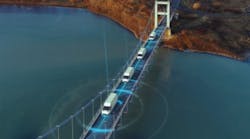While moving freight is a critical cashflow-diver for trucking companies, digital transformation is requiring them to evolve into information-based businesses that can serve ever-expanding ecosystems. To stay ahead of the competition, some trucking providers have prioritized adding cloud technology to their base offerings. During the peak of the COVID-19 pandemic, it’s been especially important for trucking companies to keep looking towards the future, while also enhancing their market position in the present.
Recognizing the massive opportunity in trucking, a $792B industry in the US alone, investors have poured $2B into trucking tech startups. Also, Uber Freight is rapidly evolving from a simple app-based logistics platform into an enterprise SaaS vendor that recently launched Uber Freight Link, a platform for enterprise shippers.
There is immense value in software connecting freight from the factory to the warehouse to the truck and on to the final mile. Trucking companies that can capture and process data that provides real-time insights to internal managers and shippers—and provide capabilities to rapidly course-correct—will be the winners in the digital age. Revolutionary trucking companies and their visionary CEOs are exploiting this market potential.
Once a trucking company’s CEO has the vision to shift into a software business and build on its track record in the freight business, there’s an effective three-phase approach that enables organizations to build a framework for digital connectivity and transform from merely trucking businesses into technology-savvy software companies.
Phase 1: Automate order processing and customs documentation
The first step of this transformation is adding a rich set of Electronic Data Interchange (EDI) capabilities for order processing and a rules engine for validating load tenders, invoices, and shipment-status messages. In addition, Application Programming Interface (API) integration is essential for trucking providers to achieve accurate load-tender processing and eliminate errors between the various transportation management systems (TMS) of freight customers.
A key part of this phase is automating the flow of customs documents for the freight business. Trucking companies can leverage Robotic Process Automation (RPA) to eliminate manual steps in document processing and routing. Furthermore, by introducing machine learning, artificial intelligence (AI), and Internet of Things (IoT) management technologies, trucking providers can dramatically consolidate and automate workflows between customers, partners and internal systems.
With this level of automation throughout the business, trucking companies increase the efficiency of internal business processes and gain clear insights into customers’ inventory statuses. By basing business decisions on these insights, freight companies can more effectively operate their supply chains.
Phase 2: Provide a visibility platform for supply chain data and smart contracts
To transition into a software business, trucking companies must have a digital platform with predictive and prescriptive insights that can serve as a marketplace for the industry. By leveraging IoT, freight companies can provide insights for trucking-route optimization, in addition to dynamic shipment tracking so partners and customers can make educated decisions in real-time. For instance, if the freight’s contents expire quickly and must be refrigerated, the sender and the recipient need to be able to track for any delays so that they can pivot accordingly if the order doesn’t arrive on time as planned.
Additionally, if freight companies harness AI, they can improve many supply-chain processes. This has been a major focus area for the industry in recent years, especially following the disruptions caused by COVID-19. Many supply chain technology vendors are scrambling to offer AI capabilities that supply chain organizations desperately need. However, even the most robust AI is rendered useless without adequate, machine-readable data to fuel AI insights.
It's extremely difficult for organizations—especially those that have not yet achieved digital transformation—to collect the needed data to make AI-powered support and insights a reality.
Phase 3: Create a trucking marketplace with an ecosystem-integration platform
With the explosive growth in freight, no single trucking company can have the driver and freight capacity to capture all loads across all trucking lanes. By recognizing this reality, visionary CEOs are embracing a marketplace-driven approach to not only create brand loyalty but also become a one-stop shop for all their shippers’ trucking needs, creating long-term loyalty and increased customer lifetime value.
Improved integration between on-premise legacy systems and cloud-based applications can provide manufacturers, retailers, logistics companies and wholesalers the critical data they need to fuel AI-powered systems. By connecting legacy systems to the cloud, trucking companies are able to leverage cloud technology without compromising the valuable on-premise systems that they have poured countless resources into.
By implementing an ecosystem-integration platform, freight businesses can rapidly onboard new shippers, freight brokerages, partners, and carriers. This cuts the time-to-market for trucking businesses by gaining access to shippers’ transportation needs. An ecosystem-integration platform also provides unparalleled visibility across the entire network.
Adapting to the future of the freight industry
With a digital-transformation strategy at work, and the steady approach it takes to make digitalization successful, trucking providers can advance their technology, offer innovative supply chain solutions, and transform into software companies. Evaluating your business with this kind of forward-thinking lens will give your enterprise the competitive edge that is needed to stay ahead of the evolving expectations of customers today.
By Mahesh Rajasekharan, CEO of Cleo


